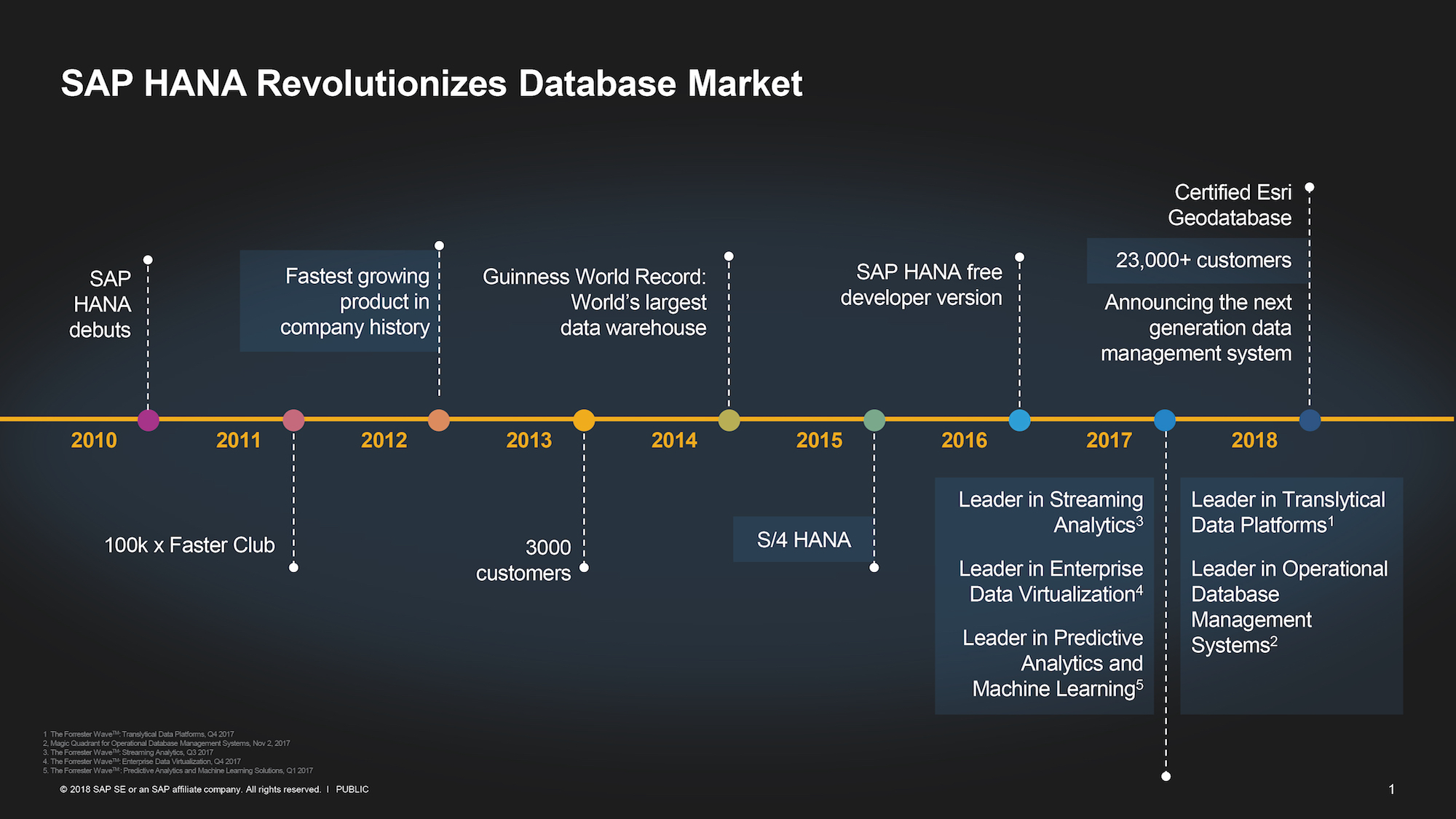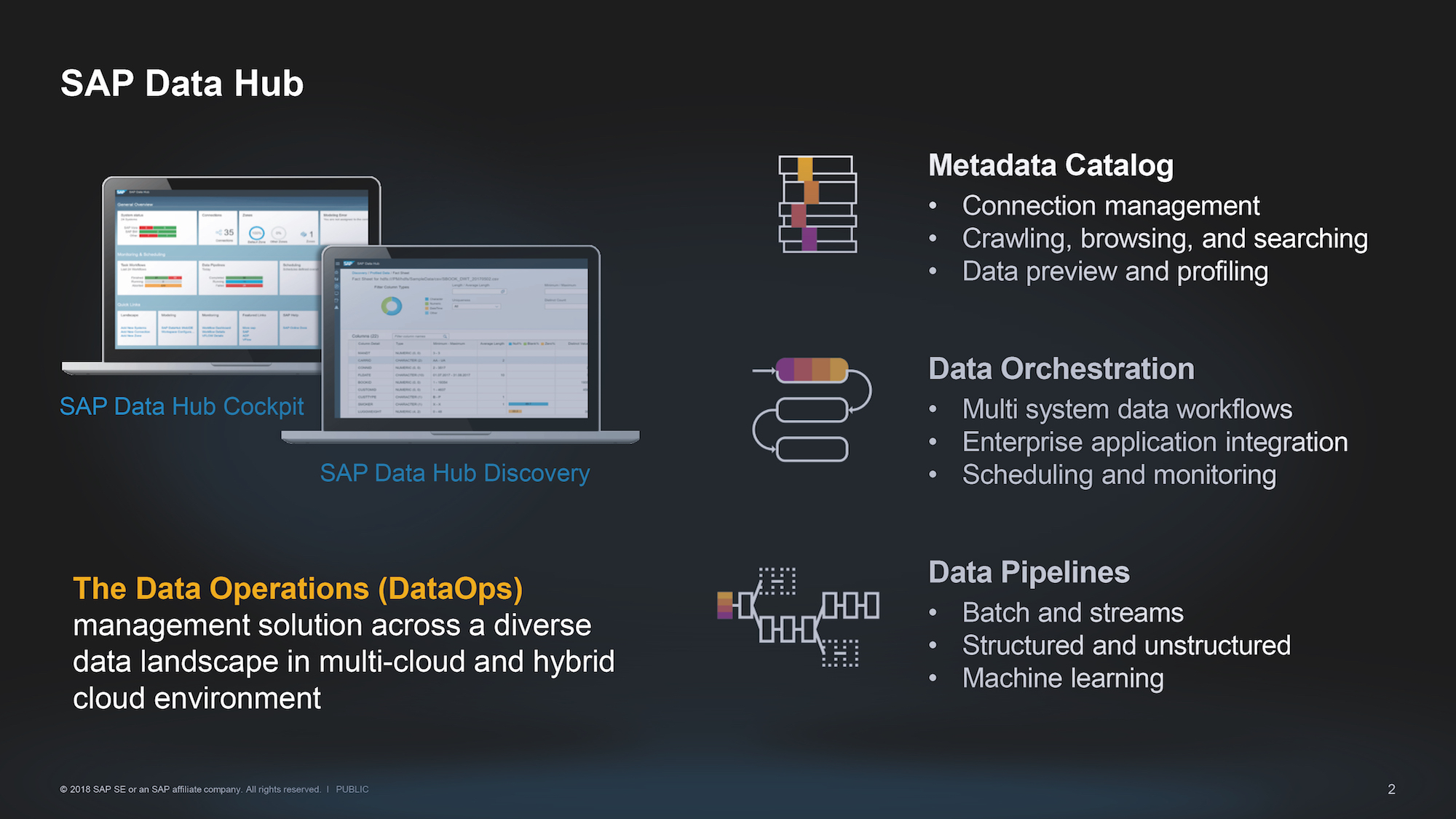“Data Transformation and Future Beyond 2018”

Greg McStravick, President, SAP Database and Data Management
Greg McStravick is the President of Database and Data Management at SAP, leading development and go-to-market (GTM) teams for SAP’s core technology innovation platform – SAP HANA® – as well as for SAP® databases (including SAP Adaptive Server Enterprise and SAP IQ), SAP solutions for enterprise information management, middleware, and SAP® VoraTM. Formerly, Greg led the GTM teams and strategy for some of SAP’s largest and fastest-growing areas of business including SAP HANA, Analytics, Database Software, and SAP Cloud Platform. With more than 20 years of progressive experience as a leader in technology solution sales management and strategy, Greg has held senior leadership positions throughout SAP, including President of U.S. operations, where he was responsible for driving customer success and developing new opportunities for SAP to expand the business across the entire United States.
My interview with Greg took place on the occasion of his visit to Prague where he delivered a keynote speech at the conference BI & HANA organized by SAPinsider, SAP’s global partner. It was a privilege for the Czech and Slovak Leaders Magazine to have the opportunity to interview Mr. McStravick on the latest development in the fast growing and changing IT industry. Despite the fact that issues such as digital transformation, Industry 4.0, market trends and disruptions due to new technologies have dominated the media coverage for a couple of years, there seems to be still a huge gap between awareness and execution. According to a poll of 1,000 CEOs with regards to digital transformation, 90 % of CEOs understood the need for digital transformation, 25 % of CEOs had a strategy and a vision how to leverage it and only 15 % went ahead and funded specific projects to take advantage. During our interview, we did not discuss only SAP HANA being the fastest growing product, but also many related issues, such as innovator’s dilemma and future trends in data management.
Prior to looking into the future, let us just take a step back to reflect the past. SAP HANA was launched in 2010. If I can make a parallel with a child’s development, psychologists claim that first seven years are the most crucial in a life. So now turning to SAP HANA as your child, how well did you manage as a parent?
SAP HANA is the fastest growing product in the history of SAP. I like the timing of the question because this year is truly the pivotal year in the history of SAP HANA’s development. During the first seven plus years, we spent the majority of our time implementing SAP HANA in customer environments mainly for SAP applications. Technically speaking, SAP HANA was designed from the ground up organically, as we did not take any existing product, instead we matured our own, because we leveraged a lot of advances that were happening in technology in general. We re-architected the way the software applications were written. This year, we realized that we have reached critical mass with our existing customers base. In order to continue SAP HANA’s growth trajectory, we needed to start positioning for being utilized outside the existing SAP applications. We have begun to look for non-SAP user cases. We have always known that SAP HANA is not only for SAP environment. But we are more and more opening our own eyes inside SAP as well as world’s eyes towards SAP HANA and a combined environment.
Let us continue along the child development analogy. Being a proud parent of SAP HANA, now maturing on her own, do you fear adolescent years coming?
You have examples of children that mature immediately with no worries and I am a confident parent knowing we have a mature child. I am not worried about getting a driver’s license and giving the child more freedom. (laughing)
As you mentioned, SAP HANA is the fastest growing product. What other achievements of SAP HANA are you the proudest of?
We have already talked about market uptake, adoption and utilization of SAP HANA. The company is and should be proud of all these three elements. The second element is pushing the frontier what can be done. We continue to challenge ourselves to differentiate SAP HANA as opposed to the competition. When you introduce a product to the market, it is pretty easy for fast followers to copy your intellectual property and to catch up with you. With our development company, we have spent a huge amount of energy and engineering effort to make sure we are ahead of the market, by doing anonymization in our databases or connecting data sources and cloud on data hub. The third element, being the result of the previous ones, we have demonstrated, both internally and externally, that SAP is not just an ERP company. (ERP: enterprise resource planning – remark by the author). Companies that get comfortable in their existing environment do not last very long.
The innovators dilemma was one of the themes of your keynote in Prague titled Future Beyond 2018 and data transformation. For those who could not have attend it, can you summarize your main message?
I call companies that fail to innovate “digital dinosaurs”. One example of such a business is Blockbuster. But there are many more. Look at the list of Fortune 500 companies. 40 % of those companies featured now were not mentioned 10 years ago. I am truly proud that SAP has been able to reinvent itself and put itself into data management and database market.
We have reached Industry 4.0 phase. This one is defined by cyber-physical systems triggered by technology. These intelligent systems use the available technology which allow us to change not only the way we run businesses but the way we run our lives. All is connected to technology data and creation of data. These cyber-physical systems will leverage features like artificial intelligence (AI) and machine learning to self-correct, to learn and to evolve. The vision aims at companies that can run themselves in a lot of ways more effectively just by putting these systems. However, the systems need data, as they are fueled by them.
Can you provide one specific example of an industry that can transform itself and data is the only thing that is limiting it?
I use the example of auto insurance industry. The practice goes as follows: they compare two males, approximately the same age, geography, type of a car and perhaps few other details such as driving history or average mileage and based on the limited and rather similar data sets, they issue the same price for the two individuals, charged either monthly, bi-annually or annually. This model does not work. There are 1.4 billion cars in the world and their collective utilization rate is 4 %. That means there is 96 % excess capacity. Those having their car parked in the garage should realize that they are paying to park something they are not using. Does it make sense? Not to the young generation that does notwanttobeanchoredtoacaranymore.Most insurance policies are anchored to a car, at least in the US. This is going to change. But look at other data available: what time of a day one is driving, what is the weather generally like, what are personal driving patterns such as exceeding speed limits, changing lines frequently or getting too close to other cars? All these geospatial data are available, most of them in mobiles already. Start-up insurance companies will completely change the traditional pricing models. The future model will be dynamic, based on the individual driver and his capabilities, actual time and conditions. Basically, it will be a utility bill per time when driving.
I have mentioned this example how a digital native could come and disrupt existing enterprises in the industry. The existing companies must face either innovator’s dilemma or fear being disrupted. That is why I started by mentioning Fortune 500 flipping so often.
We have discussed data a lot. How can we make sure that we distinguish data quantity from data quality? In past, we have seen that certain innovations were not as successful as they were expected, for the very reason of being based on the wrong set of initial data. The example often cited is the first generation of seat belts that used to be harmful for smaller women and men, as the dummies testing those were based on data available based on the sample population of army soldiers.
Are you familiar with the saying perfection is the enemy of good? Had not we tested the first generation of seat belts, we would not have learned how to improve them. Fear of not having a perfect solution for me is not a reason not to move forward. The same thing applies to AI and machine learning. Having said that, I need to stress that the entire world of cloud infrastructure allows you, as a data scientist or a business analyst, to try and safely fail on new cases and scenarios. Elastic computing, elastic infrastructure and software as service, which is provided by the cloud, can quickly spin up and try use cases that might change the way the business works. Six months later, you might find that the solution is not working. However, as you did not have to invest into hardware, software, infrastructure and others, the fear of failure is reduced. Barriers of execution have come down through the advances in the cloud. At the same time, there are many tools available that provide data cleansing, data nomenclature and other tasks. Our system SAP Data Hub, a part of SAP HANA Data Management Suite, is designed to connect SAP HANA to other data sources. You rightly pointed out that we need track and traceability. We need to know where these data were sourced from, we need to know how old the data is or whether the data has been transformed since it was created. All of these functions are capable through Data Hub and Data Management Suite, so you begin to prequalify and know that you have therightdataandtherightdataneededforthe right algorithm or the process you are trying to create. Most companies have six to eight different clouds, so data truly sits everywhere.
Digital transformation can be characterized by a huge gap between awareness and action. What can be the wake-up call?
As we have discussed the potential of disruption, I would really challenge companies to leverage cloud infrastructure to try different scenarios. By 2025, a 40% increase in labor productivity is expected due to digital transformation. This will happen in seven years! Are companies ready? On top of that, 70 % of data used for digital transformation projects will come from outside of the companies. I have mentioned auto insurance, cars providing driver performance data will enable car companies to enter data business. Likewise, one US sports apparel manufacture is collecting data about perspiration, nutrition, work out etc. and hospitals have already talked to them interested about acquiring the data. We have GDPR on one hand but on the other hand there are movements that require companies to value data and put them on the balance sheet.
What is your final message to Czech and Slovak Leaders Magazine readers?
It was my pleasure to talk about Industry 4.0 and the consequences on the future of business and society as a whole. Companies do need to challenge themselves and I encourage them to think through some innovative use cases how to leverage data to digitally transform. Last but not least, I ask them to challenge SAP to help them. We offer design thinking, we have both tools and people available that will allow them to try and fail or even better, try and succeed.
By Linda Štucbartová



